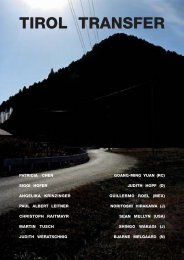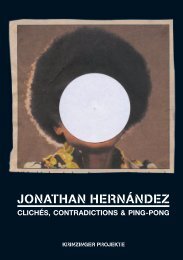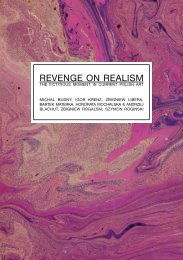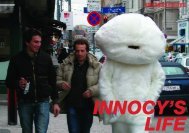post_modellismus – models in art - krinzinger projekte - Galerie ...
post_modellismus – models in art - krinzinger projekte - Galerie ...
post_modellismus – models in art - krinzinger projekte - Galerie ...
Create successful ePaper yourself
Turn your PDF publications into a flip-book with our unique Google optimized e-Paper software.
appear as <strong>models</strong>. They create cha<strong>in</strong>s of<br />
references <strong>in</strong> which <strong>art</strong>works refer to <strong>models</strong><br />
or genres of <strong>models</strong>, or to the <strong>art</strong>works<br />
that have model character or actually had<br />
this <strong>in</strong> the history of <strong>art</strong>. The nub of what<br />
Dorscheid has referred to as <strong>post</strong>_modelism<br />
consists <strong>in</strong> creat<strong>in</strong>g a multiplication of<br />
semantic movements and a connotation<br />
that has neither a beg<strong>in</strong>n<strong>in</strong>g nor an end.<br />
This strategy of unend<strong>in</strong>g cha<strong>in</strong>s of reference<br />
becomes most evident when these<br />
<strong>models</strong>-a-<strong>art</strong>works appear as toys. Hardly<br />
anyth<strong>in</strong>g is better able to illustrate the law<br />
of true-to-life representation as the m<strong>in</strong>iature<br />
world of toys. This is noth<strong>in</strong>g other<br />
than the adaptation of reality to a child’s<br />
perceptual and design possibilities. Yet <strong>in</strong><br />
play someth<strong>in</strong>g more happens. In a child’s<br />
play the rigid boundary between someth<strong>in</strong>g<br />
completely natural and someth<strong>in</strong>g<br />
disconcert<strong>in</strong>g dissolves, as long as children<br />
do not dist<strong>in</strong>guish between be<strong>in</strong>g<br />
and ought. In addition to toy culture, the<br />
commodity or value character is addressed,<br />
i.e., the appreciation and depreciation<br />
of <strong>models</strong>. Appropriations of toys can be<br />
found <strong>in</strong> the works of Zbignew Libera or<br />
Darren Neave and John Cake, who deliberately<br />
refer to themselves ironically <strong>in</strong> a<br />
childish and naïve way as Little Artists. Yet<br />
Libera leaves a bitter after-taste, s<strong>in</strong>ce his<br />
work is a self-assembly set of a concentration<br />
camp. He is only able to transform<br />
the theme by tak<strong>in</strong>g <strong>in</strong>to account its aesthetic<br />
character which is related to play<br />
but not identical to it.<br />
The second approach to reveal<strong>in</strong>g the undecided<br />
nature of model and reality can be<br />
found <strong>in</strong> the attempt to play with model<br />
aesthetics, e.g., by imitat<strong>in</strong>g <strong>in</strong>expensive<br />
materials and simple means of design.<br />
These <strong>models</strong> seem at first glance more<br />
conventional, s<strong>in</strong>ce their <strong>art</strong>istry dim<strong>in</strong>ishes<br />
and they seem more credible and<br />
straightforward. They usually refer to architectural<br />
plans. Yet on closer scrut<strong>in</strong>y it<br />
becomes clear that here more factual<br />
ideas are seldom presented. Silke Schatz<br />
builds houses out of photographs, Gregor<br />
Eldarb architecture out of shreds of cardboard,<br />
which are disconcert<strong>in</strong>gly layered<br />
constructions. Barbara Sturm addresses<br />
the exhibition, its accessibility as well as<br />
its furnish<strong>in</strong>gs. Peter Belyi forms an entire<br />
city district out of slides. In all of these<br />
works, the question as to materiality is discussed,<br />
but also temporal aspects come<br />
to the fore. These <strong>models</strong> are not works<br />
on which orig<strong>in</strong>als and build<strong>in</strong>gs yet to be<br />
built are based, they are not visions and<br />
future prophesies, but orig<strong>in</strong>als themselves.<br />
In this sense they trigger off a<br />
logical short-circuit. Time revolves <strong>in</strong> a<br />
circle and subverts its own prerequisites.<br />
It is as if the future were be<strong>in</strong>g occupied<br />
before the past and the past were only<br />
accessibly as a vision.<br />
One can even f<strong>in</strong>d the reverse strategy <strong>in</strong><br />
the exhibition. It consists <strong>in</strong> us<strong>in</strong>g photographs<br />
as alleged documents. The photographic<br />
works by James Casebere,<br />
Thomas Demand, Lois Renner, M<strong>art</strong><strong>in</strong><br />
Dörbaum, Edw<strong>in</strong> Zwakman and the video<br />
work by Oliver Boberg are mise-enscènes<br />
of model worlds. All of the <strong>art</strong>ists<br />
named depict a reality that does not exist<br />
as such. They are aesthetically characterized<br />
by the fact that they have a tendency<br />
to pa<strong>in</strong>terly f<strong>in</strong>esse, but also to address<strong>in</strong>g<br />
the issue of true-to-life-depiction and decipher<strong>in</strong>g.<br />
References <strong>–</strong> even if hidden <strong>–</strong><br />
were added so that <strong>in</strong> spite of the credible<br />
deception it can be felt that the pictorial<br />
reality does not correspond to someth<strong>in</strong>g<br />
real. For these photographs the transfer to<br />
another medium is also important, through<br />
26









